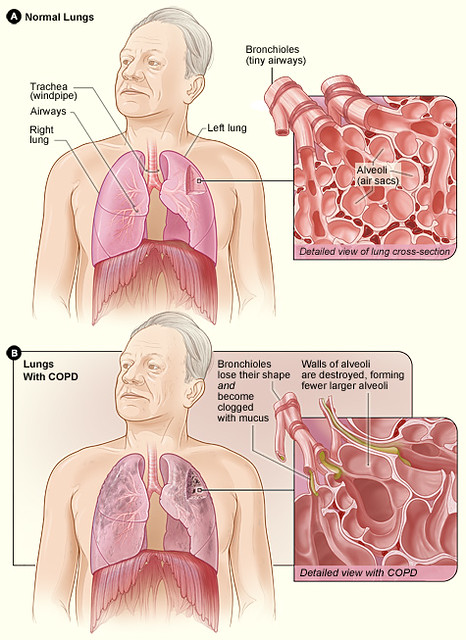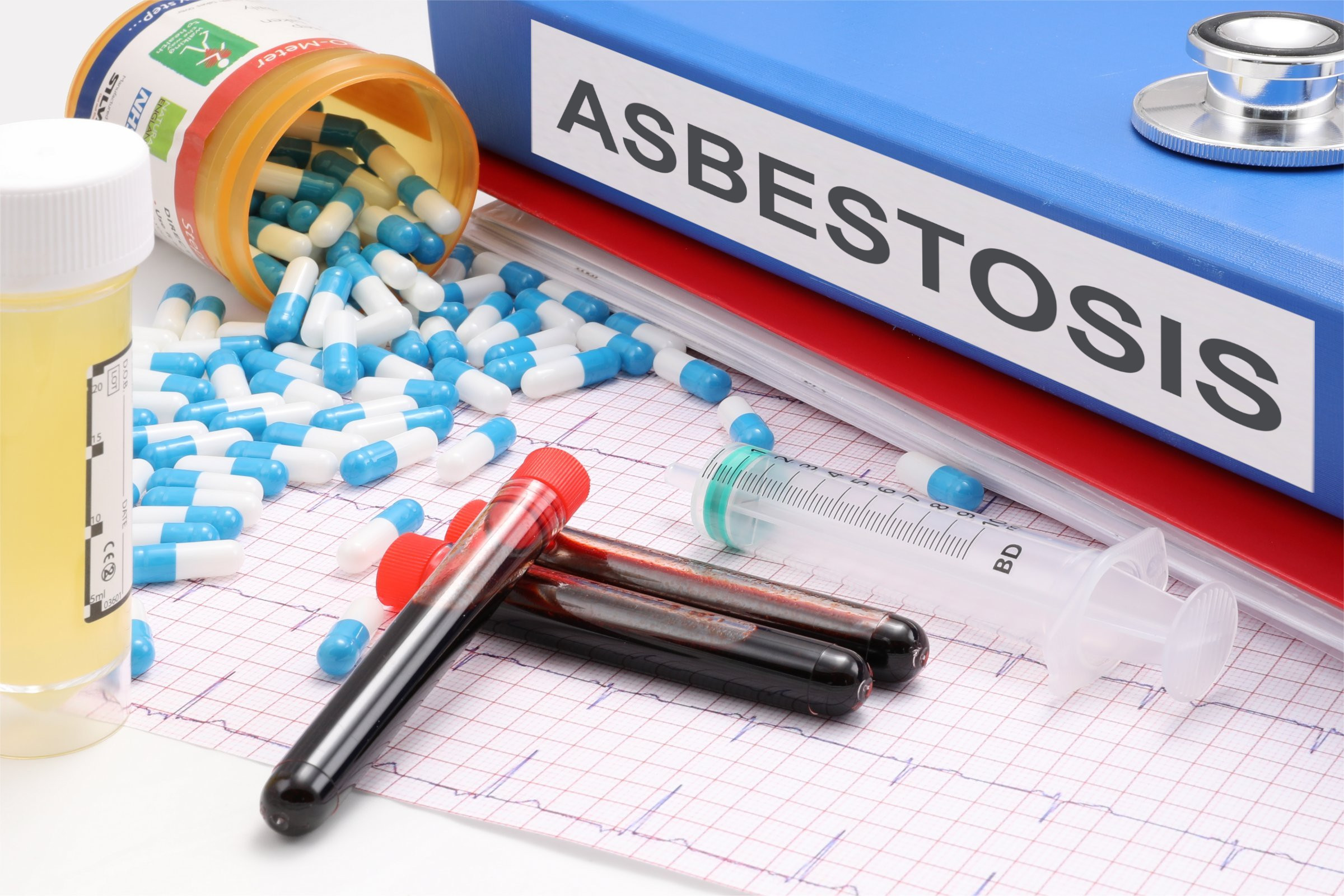Difference Between Asbestosis and Chronic Obstructive Pulmonary Disease (COPD)

Overview
Long term exposure to asbestos fibers weakens the lungs and causes a disease named – asbestosis. People who suffer from asbestosis develop Chronic Obstructive Pulmonary Disease (COPD)
Asbestos is a mineral used in many industrial set-ups. Workers who work in these industrial systems inhale fumes or asbestos fibers that cause irritation and scarring of the lungs resulting into a condition called COPD.
Causes
Asbestosis is a disease that develops over a period of time. It is common in workers who are exposed to asbestos dust for a long duration of time. Some of the asbestos fibres float in the air and eventually find their way into the alveoli – small sacs inside the lungs where there is interchange of oxygen and carbon dioxide in your blood. These fibres scar, irritate and damage the lungs leading to stiffness of lungs making it extremely difficult to breathe.
As this condition (asbestosis) progresses, lung tissues continue to get more and more diseased and damaged resulting it reducing the contracting and expanding ability of the lungs.
Smoking appears to increase the retention of asbestos fibres in the lungs, and often results in a faster progression of the disease.
Risk factors
People who are asbestos miners or work in manufacturing, installation and distribution of asbestos products are vulnerable and prone to the risk of asbestosis
Other industries include auto mechanics, electrical industry, boiler operators, building construction industry, mills and refineries, and shipyard workers
Asbestos fibres can travel to the homes of workers (on their clothing) working in the above industries thus putting other family members at risk.
Complications
- Risk of developing lung cancer
- Malignant mesothelioma

Correlation Between Asbestos and COPD
COPD is a result of inhalation of toxic foreign agents or irritants. These irritants are asbestos fibres available at the workplace like mills manufacturing asbestos. Workers who are exposed to long term inhalation of asbestos fibres later develop COPD.
Weak lungs triggered by chronic obstructive pulmonary disease are more susceptible to increased damage caused due to exposure to asbestos.
Various scientific studies have reported a statistically significant incidence of COPD among those exposed to toxic materials such as asbestos and silica.
Symptoms of COPD caused due to asbestos exposure
Symptoms of COPD caused due to asbestos exposure includes;
- Wheezing
- Cough with mucus (sputum) that is clear, white, yellow or greenish in color
- Bluish skin
- Respiratory infections that happen frequently
- Chest tightness or pressure and pain in chest
- Unintentional weight loss
- Breathing difficulty
- Colds and flu that happen very often
- Shortness of breath
- A cough that produces a lot of mucus
- Loss of appetite
- Edema (swelling in feet, legs and ankles)
- Fatigue or inability to exercise
- Clubbed fingers (fingertips and toes that look rounder and wider than normal)
- Low muscle endurance
With the advancement of the disease, more water retention and mucus formation take place in the lungs due to less expansion of sacs in the lungs. This creates difficulty in breathing and get adequate oxygen.
Severe symptoms of COPD that need immediate attention and emergency treatment include;
- Erratic heartbeat
- Extreme difficulty in breathing and talking
- Sudden drop in blood oxygen
- Lack of mental alertness
Diagnosing COPD
Spirometry – This test helps to determine the symptoms of COPD. In this test, one blows air into a mouthpiece attached to a tiny machine (spirometer). The machine evaluates and assesses the volume of air blown out in a second and how fast the air has been blown. Spirometry aids in detecting Chronic Obstructive Pulmonary Disease (COPD) before symptoms develop and this helps in finding out how severe your COPD is.
Other tests
- X-ray to see the condition of lungs
- Arterial blood gas test – to check the O2 level in the blood
- An electrocardiogram (ECG) – to check the electrical activity of the heart
- A CT scan – that helps to scan your lungs
- Test of phlegm sample – sputum is tested to check the infection in the chest
- An echocardiogram (also called ECHO) – an ultrasound scan of the heart
COPD prevention and treatment
Symptoms are typically treated with one or more of the following treatments:
- Lifestyle Changes
- Say No to smoking
- Avoid being a passive smoker
- Eat a healthy and nutritious diet
- Exercising and more of physical activity
- Do yoga to keep lungs from degrading
- Medications
- Bronchodilator for relaxing the muscles of the bronchi
- Steroid
- Oxygen therapy
Usage of nasal cannula, nasal prongs or mask to aid in receiving oxygen therapy in the form of supplemental oxygen. This therapy expands the lungs and makes the breathing better. A portable unit can be used throughout the day depending upon the severity of the condition.
- Surgery
- Surgery is recommended when the severity is more and when the lungs are damaged due to severe COPD or emphysema.
- This surgery is called as bullectomy. In bullectomy, abnormal large spaces in created in the lungs termed as bullae are removed by the surgeons to improve breathing.
- Another is lung volume reduction surgery in which a chest (thoracic) surgeon removes diseased, emphysematous and damaged lung tissue.
- Lung transplantation – This option is considered in cases where lungs are completely damaged.
- Endobronchial valves (EBV) – an implantable medical device which is a tiny device used to improve lung function by improving the efficiency of airflow in lungs by diverting inspired air (air entering the lungs) to healthy lungs and away from non-functioning, diseased lungs.
Is asbestosis a restrictive or obstructive lung disease?
Asbestosis is an interstitial pulmonary fibrosis which caused from inhalation of asbestos fibers, and therefore it leads to restrictive pattern of disease. In some cases it leads to progressive exertional dyspnea.
Is COPD the same as chronic obstructive lung disease?
Yes it is. COPD is a short form of Chronic obstructive pulmonary disease (COPD). It is a chronic inflammatory lung disease that leads to obstructed airflow from the lungs. Some of the signs and symptoms are difficulty breathing during exertion and at rest, cough -productive or non productive, mucus production (sputum) production and wheezing during COPD exacerbation.
Can Mesothelioma be misdiagnosed as COPD?
Misdiagnosis can occur due to the rarity of the Mesothelioma cancer. For example, symptoms of pleural mesothelioma can be misdiagnosed as pneumonia or COPD. Therefore, those who has a known asbestos exposure and symptoms must seek a second opinion from a mesothelioma specialist.
Can asbestos cause CF?
In some cases of idiopathic pulmonary fibrosis (IPF) can occur due to environmental or occupational exposure to asbestos.
How long can you live with asbestosis?
On average asbestos-related lung cancer life expectancy is around 16.2 months based on the individual. An asbestos-related lung cancer prognosis should be determined by a lung cancer specialist and prognosis can be improved through many treatments such as chemotherapy, surgery and immunotherapy.
How long can you survive with asbestosis?
Mesothelioma Life Expectancy with Surgery by Stage
Stage Life Expectancy
Stage 1 22.2 months
Stage 2 20 months
Stage 3 17.9 months
Stage 4 14.9 months
- Difference Between Global Warming and Greenhouse Effect - May 18, 2024
- Difference Between Vaccination and Immunization - March 3, 2024
- Difference Between Selective Mutism and Autism - February 25, 2024
Search DifferenceBetween.net :
Leave a Response
References :
[0]Barnhart, S., Hudson, L. D., Mason, S. E., Pierson, D. J., & Rosenstock, L. (1988). Total lung capacity: an insensitive measure of impairment in patients with asbestosis and chronic obstructive pulmonary disease? Chest, 93(2), 299-302.
[1]Hui, K. P., & Hewitt, A. B. (2003). A simple pulmonary rehabilitation program improves health outcomes and reduces hospital utilization in patients with COPD. Chest, 124(1), 94-97.
[2]Petty, T. L. (2003). Definition, epidemiology, course, and prognosis of COPD. Clinical cornerstone, 5(1), 1-10.
[3]Sporn, T. A., & Roggli, V. L. (2014). Asbestosis. In Pathology of asbestos-associated diseases (pp. 53-80). Springer, Berlin, Heidelberg.
[4]Image credit: https://pix4free.org/assets/library/2021-03-25/originals/asbestosis.jpg
[5]Image credit: https://live.staticflickr.com/3709/32486640184_1b52b3af0f_z.jpg
